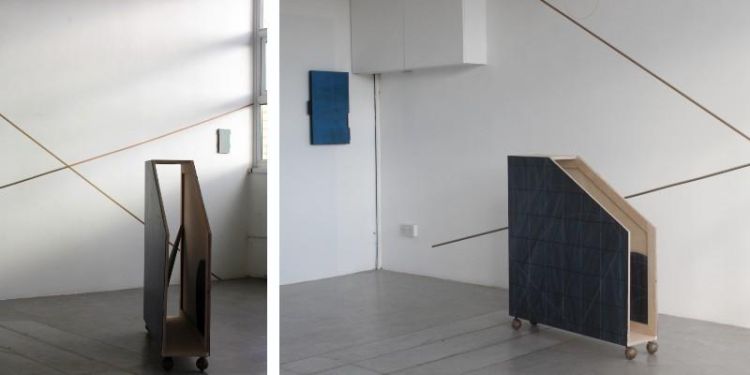Contested threshold: perceptual modalities for painting caught by the spine screen at E-1027

- Date: Wednesday 14 May 2025, 14:00 – 15:30
- Location: Fine Art Building SR (G.04)
- Cost: Free
You are invited to a research seminar hosted by the School of Fine Art, History of Art and Cultural Studies, with speaker Dr Moyra Derby.
In this research seminar, Moyra Derby (Associate Professor in the School of Fine Art, History of Art and Cultural Studies) will present in-progress research on a curved and pigmented screen structure designed by Eileen Gray at villa E-1027 in 1929.
Here the practice basis of the research will also be explored by sharing documentation from three recent exhibitions: ‘room plan’ at Studio 3 gallery at the University of Kent; ‘In Correspondence’ at RaumX, London; and ‘Diagramming: the space of a painting, the space of a room’ at the Foundry Gallery, London.
An earlier version of this research was presented at the Design History Society conference Border Control: Excursion, Incursion and Exclusion in 2024.
Abstract
A blue pigmented partition inscribes the transition from entrance to interior at Eileen Gray’s villa E-1027 and its multi-sensory invitation opens up a consideration of a cognitive undertow to disciplinary boundaries and gendered hierarchies within early modernism. The screen operates in a category slippage between architecture, interior design and furniture, and – as this presentation explores – painting.
Eileen Gray sustained a private engagement with a painting practice throughout her career, while regretting a pictorial influence on the architecture of her peers, and the dematerialised and optically registered conception of spatial encounter this produced.
Acquired by the Conservatoire du littoral in 1999, the restoration project at E-1027 has reignited a tension between Eileen Gray’s conception of interior space and a series of figurative murals that were added by Le Corbusier in the 1930s. The spine screen was dismissed by Le Corbusier as unnecessary clutter, but the fluidity it demonstrates between function and aesthetics – facilitating a cognitive and spatial shift from social to private areas within the villa – it is a pivot point in Gray’s conception of interior space and interior life.
Proposing the spine screen’s resonance as painting offers a new perspective for considering these contentious pictorial intrusions by Le Corbusier, and to consider the spatial and durational aspects of painting and its relationship to interior space.
About Moyra Derby
Moyra Derby is an artist and researcher with a painting-based studio practice that informs exhibition making, writing, curation and collaboration. Moyra is Associate Professor of Fine Art in the School of Fine Art, History of Art and Cultural Studies at the University of Leeds. Prior to joining the school in 2024, Moyra taught at the University for the Creative Arts at Canterbury.
More information
This seminar is organised by the School of Fine Art, History of Art and Cultural Studies. It is free to attend and all are welcome.
Please register here if you would like to attend.
For more details, please email Ross Truscott at R.Truscott@leeds.ac.uk.
Images
Moyra Derby, painting components for ‘In Correspondence: Moyra Derby and Della Gooden, Raumx, London 2022. Photo courtesy of Moyra Derby.

